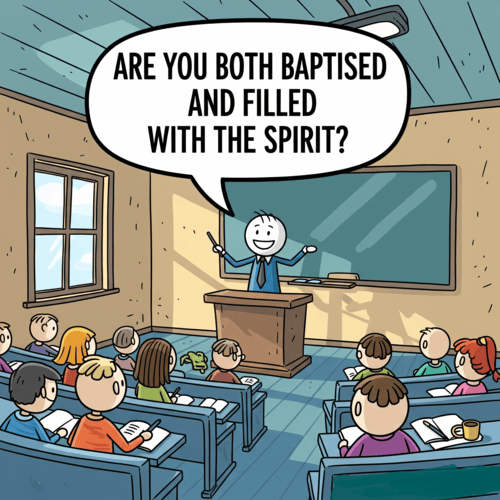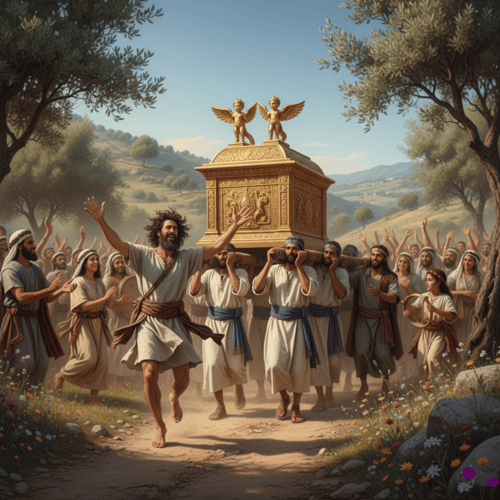David Danced Before the Lord—Why Don’t Reformed Churches?
When we read about King David leaping and dancing before the Lord “with all his might” (2 Samuel 6:14), a question arises in our minds: if worship moved David to dance, why do Reformed churches seem so reserved?
Well, the answer isn’t about suppressing joy or rejecting physical expression. It’s about understanding what God has actually prescribed for corporate worship versus personal celebration. The distinction matters more than we, perhaps, realise…
THE REGULATIVE PRINCIPLE: WORSHIP BY COMMAND, NOT PERMISSION
Reformed churches follow what’s called the Regulative Principle of Worship (RPW): the conviction that corporate worship must include only what God commands in Scripture, not merely what He permits. This isn’t legalism—it’s reverence for God’s authority over His own worship.
- Scripture takes unauthorised worship seriously. When Nadab and Abihu offered “unauthorised fire before the LORD, contrary to his command,” God’s judgement was immediate and fatal (Leviticus 10:1-3). When Uzzah steadied the ark with good intentions but wrong method, he died on the spot (2 Samuel 6:6-7). These aren’t arbitrary warnings—they reveal God cares deeply about how we approach Him.
- Jesus Himself taught true worshipers must worship “in spirit and in truth” (John 4:23-24). Worship isn’t whatever feels spiritual to us; it’s what God has revealed as acceptable.
- What has God prescribed for New Covenant worship? The apostolic pattern is clear: the reading of Scripture (1 Timothy 4:13), preaching the Word (2 Timothy 4:2), prayer (1 Timothy 2:1-2), singing psalms, hymns, and spiritual songs (Ephesians 5:19; Colossians 3:16), the sacraments of baptism and the Lord’s Supper (Matthew 28:19; 1 Corinthians 11:23-26), and the collection for the saints (1 Corinthians 16:1-2).
Notice what’s absent: any command or apostolic instruction to include dance in the corporate worship assembly. Is the silence accidental oversight?
VIEWING DAVID’S DANCE IN CONTEXT
“But didn’t David dance?” Sure he did—but context is everything. David’s dance occurred during the procession bringing the ark of the covenant to Jerusalem (2 Samuel 6:14-15). This was a unique, unrepeatable moment in redemptive history, not a pattern for weekly worship. Similarly, Miriam danced after crossing the Red Sea (Exodus 15:20)—a celebration of an extraordinary deliverance, not a template for synagogue worship.
Would David have danced in the Holy Place? Notably, David could never have danced in the tabernacle’s Holy Place during prescribed worship. Old Covenant worship was highly choreographed by God’s explicit ceremonial laws—who could enter where, when, wearing what, doing exactly what God commanded. David didn’t freelance in corporate worship; his dance was personal celebration during a procession.
Personal devotion versus corporate prescription—a crucial distinction. David also wrote psalms in caves and played his harp privately, yet we don’t require caves or harps in Reformed worship. The question isn’t “Did any biblical figure ever dance?” but “Did God command dance for the covenantal assembly of His people?”
Furthermore, Christ fulfilled the ceremonial law. We don’t replicate Temple ceremonies, animal sacrifices, or priestly garments. New Covenant worship is intentionally simpler—not less glorious, but more spiritual. Jesus declared that neither Jerusalem nor Mount Gerizim would be the worship centre, but that worship would be “in spirit and truth” (John 4:21-24). The physical trappings of Temple worship have given way to spiritual reality in Christ.
THE CULTURAL ARGUMENT EXAMINED
“But dance is how our culture expresses joy!” This objection deserves a thoughtful response. Yes, cultures express celebration differently, and God’s gifts to different peoples enrich the global church. However, corporate worship isn’t primarily about our cultural expression—it’s about God’s prescription.
The apostle Paul didn’t allow every culture to insert its preferences into worship. He regulated head coverings in Corinth (1 Corinthians 11), insisted on order and decency (1 Corinthians 14:40), and even forbade certain cultural practices. If culture alone determined worship, worship becomes human-centred rather than God-centred.
Here’s the beautiful paradox: the Regulative Principle doesn’t create cold worship. Reformed churches have produced some of Christianity’s most glorious music, profound theology, and passionate devotion. Constraint in worship’s form actually liberates us from the endless treadmill of innovation and entertainment-driven pressure. We’re free to focus on what God has given us, trusting His wisdom over our creativity.
WORSHIPING GOD HIS WAY
The Reformed position isn’t about being anti-joy or culturally rigid. Christians who include dance in their services often have sincere, God-honouring motives. But sincerity doesn’t establish biblical warrant. The central question remains: does Scripture prescribe dance for the corporate worship assembly of the New Covenant church? The honest answer is no.
This doesn’t mean we can’t celebrate physically. Dance at weddings, rejoice in your homes, express joy in private devotion—all these have their place. But when God’s people gather on the Lord’s Day in covenant assembly, we follow the apostolic pattern: Word, sacrament, prayer, and song.
The Regulative Principle protects the church from human innovation and keeps worship centred on God’s revealed will. What God has prescribed is sufficient, and it’s glorious. We can trust He knows best how He wants to be worshiped. Following His design leads to the deepest, truest joy.
DAVID DANCED BEFORE THE LORD—RELATED FAQs
Would impromptu dance be okay, say during family worship at home? Family worship operates under different principles than corporate Lord’s Day worship. The Regulative Principle specifically governs the covenantal assembly of God’s people under appointed elders, not private devotional practices. In family worship, fathers exercise headship with appropriate liberty—children might clap, families might stand or kneel, and spontaneous expressions of joy aren’t regulated in the same way. However, wise fathers may still choose to prioritise the elements God has given (Scripture reading, prayer, singing, instruction) and model reverence, teaching children worship is about God’s pleasure, not ours.
- What do churches following the Normative Principle believe about dance in worship? Churches holding the Normative Principle (rather than the Regulative Principle) believe anything not explicitly forbidden in Scripture may be included in worship, as long as it’s edifying and orderly. This includes many evangelical and charismatic churches that incorporate dance, drama, and other forms of creative expression. They would argue since Scripture doesn’t prohibit dance in corporate worship, and since it appears in contexts like David’s celebration, it’s permissible today. The fundamental disagreement is about hermeneutics: does God’s silence permit or prohibit? Reformed churches believe God’s silence prohibits what He hasn’t commanded for covenant worship.
- What about raising hands during worship—is that different from dancing? Raising hands in prayer and worship is explicitly mentioned in Scripture as a posture of prayer and praise (Psalm 134:2; 141:2; 1 Timothy 2:8). While Reformed churches don’t require this gesture, it has biblical warrant as a prayer posture, unlike dance in corporate worship. The key distinction is prescription: Scripture gives us this as a way God’s people have prayed. That said, Reformed churches generally caution against making hand-raising a litmus test of spirituality or allowing physical expressions to become distracting performances. The focus remains on the heart’s posture before God.
Did the early church include dance in worship services? Historical evidence suggests the early church did not. Early church fathers like Chrysostom and Ambrose actually warned against theatrical performances and dance in worship, associating them with pagan practices. The early Christian worship pattern—evident in Acts, the Epistles, and documents like the Didache—centred on Scripture reading, preaching, prayer, psalms/hymns, and the Lord’s Supper. This continuity with synagogue worship (purified and fulfilled in Christ) excluded dance. The simplicity of early Christian worship supports the Reformed position that apostolic instruction, not cultural innovation, should govern our assemblies.
- Isn’t restricting dance just Western cultural bias against physical expression? This charge deserves careful consideration, but ultimately reverses the issue. The question isn’t whether any culture should express itself physically, but whether any culture (Eastern or Western) has authority to add to what God prescribed. Many non-Western Reformed churches—African, Asian, Latin American—hold firmly to the Regulative Principle precisely because it prevents worship from being hijacked by any cultural agenda. Reformed Christians celebrate diverse cultures outside worship while maintaining that corporate worship’s content comes from Scripture, not culture. This protects minority voices and prevents dominant cultural groups from defining worship according to their preferences.
- What about children’s ministries or youth groups—can they include dance? These contexts require wisdom and distinction. If children’s programs or youth gatherings are understood as Christian education, fellowship, or evangelistic outreach rather than covenant worship assemblies, there’s more liberty for age-appropriate activities, including creative movement for young children learning biblical truths. However, even in these settings, leaders should be cautious about teaching children that dance is “worship,” which could confuse them about corporate worship’s nature. The goal is preparing the next generation to value God’s ordained means of grace—Word, sacrament, prayer, and song—not training them to expect entertainment-driven experiences. Wise church leaders will maintain the distinction between para-church activities and the worship assembly.
If someone feels moved by the Spirit to dance during a worship service, should they suppress it? Reformed theology emphasises the Holy Spirit leads believers according to Scripture, not contrary to it. The Spirit who inspired the apostolic instructions for orderly worship (1 Corinthians 14:26-40) won’t contradict His own Word by prompting actions He hasn’t prescribed for corporate worship. Genuine spiritual impulses should align with biblical patterns; feelings of joy or emotional intensity can be expressed through the prescribed means—singing with gusto, heartfelt “Amens,” focused attention on preaching, fervent prayer. If someone feels compelled to dance, this is an opportunity for biblical discipleship: teaching that the Spirit’s leading conforms to Scripture, and that true spiritual freedom means joyfully submitting to God’s wisdom about worship rather than following subjective impressions.
DAVID DANCED BEFORE THE LORD—OUR RELATED POSTS
Editor's Pick
‘Because Angels Are Watching’: What Does 1 Corinthians 11:10 Mean?
“For this reason the woman ought to have authority on her head, because of the angels” (1 Corinthians 11:10, ESV). [...]

Why Does God Torment Saul With An Evil Spirit?
Would a holy God send an evil spirit to torment someone? This theological puzzle confronts us in the biblical account [...]

Paul’s Teaching on Women’s Roles: 1 Timothy 2:12 Explained
YARBROUGH’S BIBLICAL CASE FOR COMPLEMENTARIANISM In a world of shifting cultural values, few biblical texts generate as much discussion as [...]

What Does the Bible Really Mean By ‘The Flesh’?
8The phrase "the flesh" appears over 150 times in the New Testament, making it one of the most significant theological [...]

Does God Still Talk Directly To His People?
"God told me to take this job." "I feel the Lord leading me to marry her." Such phrases echo through [...]

Will There Be a Third Jewish Temple in Jerusalem?
Throughout history, God's dwelling among His people has taken several forms—from the wilderness tabernacle to Solomon's magnificent temple, to its [...]

Filled Vs Baptised With the Spirit: What’s the Difference?
Filled vBaptised with the Holy Spirit vs. filled with the Spirit: are these simply different terms for the same spiritual [...]

Joshua & Yeshua: Exploring the Name and Life Connections
When we encounter names in Scripture, they often carry profound theological significance. None more so than the name shared by [...]

Can Evil Spirits Read Minds? What Scripture Actually Teaches
Ever worried Satan or his demons can see your thoughts? Perhaps you’ve had a sinful thought and immediately felt exposed, [...]
Does a Husband’s Faith Save His Family? Acts 16:31 Explained
"Believe in the Lord Jesus, and you will be saved, you and your household." This promise in Acts 16:31 has [...]
SUPPORT US:
Feel the Holy Spirit's gentle nudge to partner with us?
Donate Online:
Account Name: TRUTHS TO DIE FOR FOUNDATION
Account Number: 10243565459
Bank IFSC: IDFB0043391
Bank Name: IDFC FIRST BANK








